- Joined
- Oct 9, 2007
- Messages
- 47,435 (7.51/day)
- Location
- Hyderabad, India
| System Name | RBMK-1000 |
|---|---|
| Processor | AMD Ryzen 7 5700G |
| Motherboard | ASUS ROG Strix B450-E Gaming |
| Cooling | DeepCool Gammax L240 V2 |
| Memory | 2x 8GB G.Skill Sniper X |
| Video Card(s) | Palit GeForce RTX 2080 SUPER GameRock |
| Storage | Western Digital Black NVMe 512GB |
| Display(s) | BenQ 1440p 60 Hz 27-inch |
| Case | Corsair Carbide 100R |
| Audio Device(s) | ASUS SupremeFX S1220A |
| Power Supply | Cooler Master MWE Gold 650W |
| Mouse | ASUS ROG Strix Impact |
| Keyboard | Gamdias Hermes E2 |
| Software | Windows 11 Pro |
A Chinese tech community MyMyPC.com member pictured, and tested a Radeon HD 5750 graphics accelerator, which is intended to be AMD's flagship product in the sub $150 market segment. Unlike the Radeon HD 5770, which is pictured with a different cooler that resembles that of the Radeon HD 4770 (AMD reference), and Radeon HD 3870, this card makes do with a GPU cooler essentially similar to that of the more common Radeon HD 4770 cooler design, except for a few changes with the fan and the cooler shroud. Under the black, egg-shaped shroud is a heatsink with radially-projecting fins, in which is nested a red 80 mm fan. Everything else on the card, relies on its air-flow.
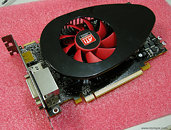
With the cooler taken apart, we get the first glimpse of the Juniper graphics processor, the next-generation successor to the RV740. Although its package itself isn't very big, perhaps because it has lesser number of memory pins, the 40 nm die certainly is larger than that of the RV740. There are four GDDR5 memory chips surrounding it, and perhaps there are four more right behind them. A simpler 3+1 phase circuit powers the card, and power is drawn from a single 6-pin connector. This reference-design board is using GDDR5 memory chips made by Hynix. The output connector cluster is identical to those of the Radeon HD 5800 series accelerators, with two DVI-D, one HDMI, and one DisplyPort. Although the specifications of the GPU aren't out yet, the driver reports that it is clocked at 700/1050 MHz (core/memory).
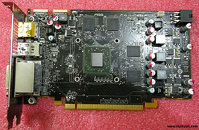
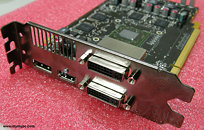
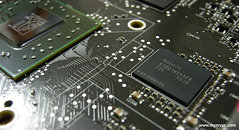
Here's the interesting part, the performance figures unearthed by the previewer. The HD 5750 was pitted against Radeon HD 4850, HD 4770, and GeForce GTS 250. At 3DMark Vantage (GPU score) and 3DMark06, the Radeon HD 5750 outperformed both the Radeons from the previous generations, and edged past the GeForce GTS 250, which were tested on the same testbed. After 220 seconds of FurMark, the Radeon 5750 was chugging along at 70 °C, with an average frame-rate of 35 fps.
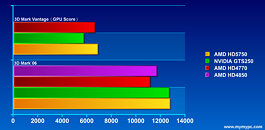
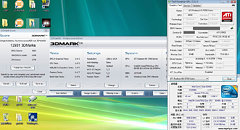
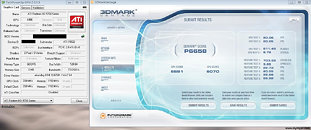
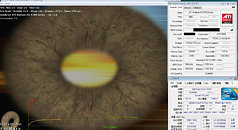
For screenshots of other accelerators used in this comparison, refer to the source. The Radeon HD 5700 series is expected to arrive around the same time when Microsoft releases its Windows 7 operating system.
View at TechPowerUp Main Site

With the cooler taken apart, we get the first glimpse of the Juniper graphics processor, the next-generation successor to the RV740. Although its package itself isn't very big, perhaps because it has lesser number of memory pins, the 40 nm die certainly is larger than that of the RV740. There are four GDDR5 memory chips surrounding it, and perhaps there are four more right behind them. A simpler 3+1 phase circuit powers the card, and power is drawn from a single 6-pin connector. This reference-design board is using GDDR5 memory chips made by Hynix. The output connector cluster is identical to those of the Radeon HD 5800 series accelerators, with two DVI-D, one HDMI, and one DisplyPort. Although the specifications of the GPU aren't out yet, the driver reports that it is clocked at 700/1050 MHz (core/memory).



Here's the interesting part, the performance figures unearthed by the previewer. The HD 5750 was pitted against Radeon HD 4850, HD 4770, and GeForce GTS 250. At 3DMark Vantage (GPU score) and 3DMark06, the Radeon HD 5750 outperformed both the Radeons from the previous generations, and edged past the GeForce GTS 250, which were tested on the same testbed. After 220 seconds of FurMark, the Radeon 5750 was chugging along at 70 °C, with an average frame-rate of 35 fps.




For screenshots of other accelerators used in this comparison, refer to the source. The Radeon HD 5700 series is expected to arrive around the same time when Microsoft releases its Windows 7 operating system.
View at TechPowerUp Main Site
Last edited:












 looks fugly dont put it in a windowed case
looks fugly dont put it in a windowed case